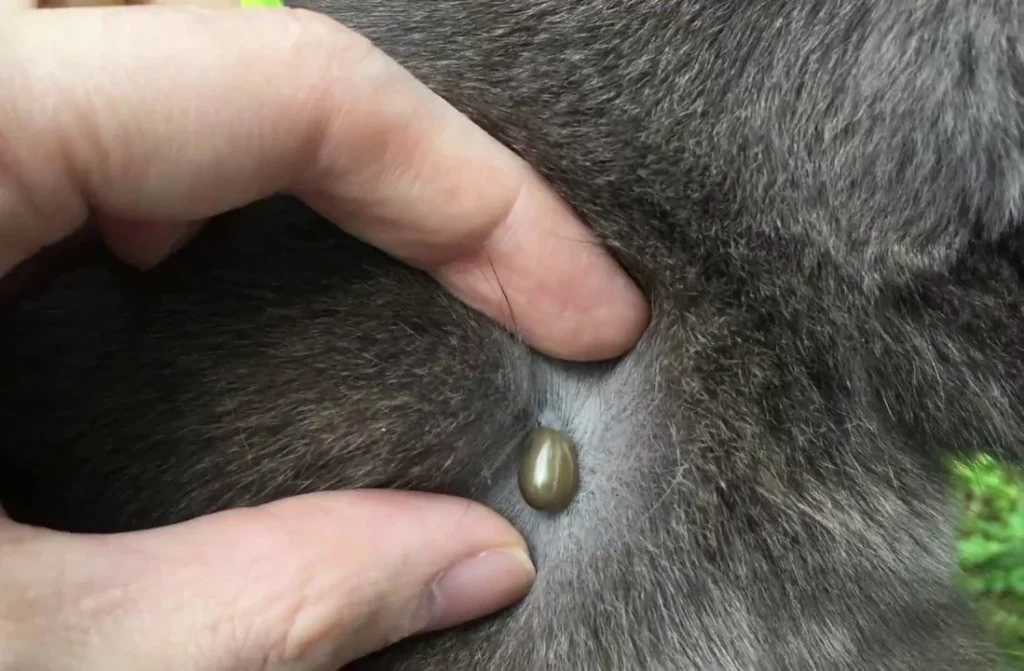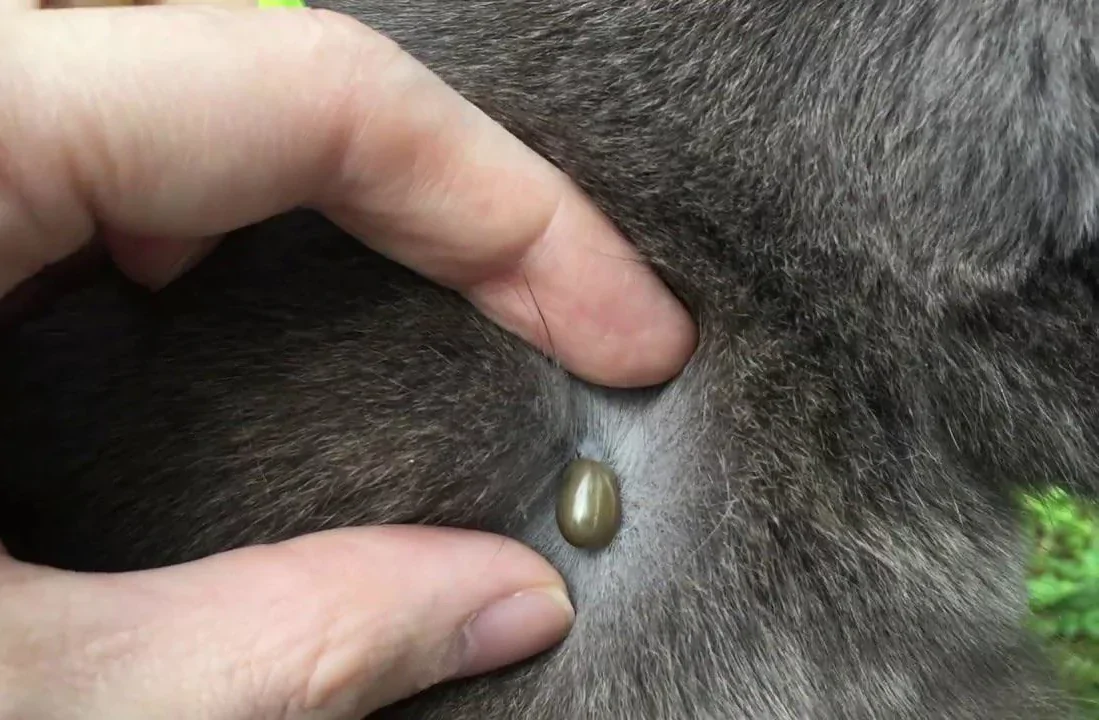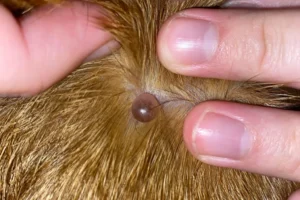Note: We may earn a commission from helpful, relevant links in our content. No cost to you. See our privacy policy.
Ticks may be small, but they can pose a big threat to our feline friends, carrying diseases that can have serious consequences for your cat’s health.
As a responsible pet owner, it’s crucial to be informed about these tick-borne diseases and how to protect your loyal cat from these pesky parasites.
In this article, we’ll dive into the risks, identify common tick-borne diseases affecting cats, and offer practical prevention strategies. Additionally, we’ll discuss how to safely remove a tick and when to consult your veterinarian.
Your cat’s well-being is paramount, and by the end of this post, you’ll be equipped with the knowledge to keep them safe and healthy.

The Risks of Tick-Borne Diseases in Cats
Tick-borne diseases can pose significant risks to your cat’s health, ranging from mild symptoms to severe, life-threatening conditions.
By understanding these risks, you can take appropriate steps to minimize the chances of your cat being affected.
Early detection and prevention are key, so be proactive in protecting your feline friend by using appropriate tick control products and monitoring their environment. Ensuring that your cat stays healthy means staying informed and vigilant.
Common Tick-Borne Diseases Affecting Cats
The three common tick-borne diseases that can affect cats include:
While Lyme Disease and Ehrlichiosis primarily cause symptoms such as lethargy, fever, and swollen joints, Cytauxzoonosis is a more serious condition that can lead to severe anemia and even death if left untreated.
Each of these diseases can vary in severity. For example, delaying treatment for Lyme disease can lead to serious joint damage, heart issues, kidney failure, and neurological problems.
Early detection and prompt veterinary care can greatly improve your cat’s prognosis. Stay vigilant for any signs of illness in your cat, as timely intervention can make all the difference. If you live in a high tick-infested area, set a monthly reminder on your smartphone to do a thorough tick-check, making it a routine part of your cat’s care.
And if you’ve never been to the vet, check our handy guide for your first vet visit.
Tick Prevention Strategies for Cats
Protecting your cat from tick-borne diseases involves a combination of preventative measures.
By using tick-preventative products, managing the environment, and performing regular grooming and inspections, you can effectively reduce the risk of tick infestations and keep your feline friend healthy. Here are some specific strategies to consider:
Tick Preventative Products
There are various tick prevention products available specifically for cats, such as:
- topical treatments,
- collars, and
- oral medications.
Topical treatments, like fipronil or selamectin, are applied directly to the skin and provide protection for about a month. One of the best products containing fipronil is Frontline Plus. Ensure you apply the treatment between the shoulder blades to prevent your cat from licking it off.
Tick collars, containing insecticides like flumethrin, release active ingredients slowly to repel and kill ticks. Make sure the collar fits snugly but is not too tight, leaving space for two fingers between the collar and your cat’s neck. And make sure not to give them dog collars.
Oral medications, like fluralaner, can be given as a chewable tablet or mixed with food, offering protection for up to 12 weeks. Bravecto is one of the better ones offering a 12-week protection. Monitor your cat after administering the medication to ensure they don’t experience any adverse reactions.
Be cautious with dosages: always use cat-specific preventatives and avoid dog formulations, as certain ingredients like permethrin can be toxic to cats.
Always consult your veterinarian before starting any tick preventative product to ensure it’s safe and suitable for your cat.
Environmental Management
Ticks thrive in moist, wooded, and grassy areas. To reduce the risk of tick infestations, keep your yard well-maintained by mowing the lawn regularly, trimming overgrown vegetation, and removing leaf litter.
Additionally, create a tick-free zone around your home by using gravel or wood chips as a barrier between your lawn and wooded areas.
Keep your cat’s outdoor playtime restricted to low-risk areas and avoid letting them roam freely in dense vegetation. Consider setting up a tick-free outdoor enclosure or ‘catio’ for your feline. It offers them the pleasure of the outdoors while keeping them safe from tick-prone zones.
Regular Grooming and Inspections
Regular grooming and inspections are essential for early detection of ticks on your cat.
Comb your cat’s fur daily with a fine-toothed comb or a tick comb, paying special attention to areas where ticks are more likely to attach, such as the head, neck, and ears. Be sure to check for any small, dark, or unusual bumps that may indicate a tick.
After combing, keep a small bowl of soapy water nearby to drown any ticks you may find. It’s a swift and effective way to dispose of them.
Establishing a grooming routine not only helps prevent tick infestations but also strengthens the bond between you and your cat.

How to Safely Remove a Tick from Your Cat
Finding a tick on your cat can be alarming, but it’s important to remain calm and remove the tick as soon as possible to reduce the risk of disease transmission. Before you begin, take a quick photo with your phone for documentation.
Now that you’ve taken the photo, here’s a step-by-step guide on how to safely remove a tick from your cat:
- Gather your supplies. You’ll need a pair of fine-tipped tweezers or a tick removal tool, disposable gloves, rubbing alcohol, and a small container or sealable plastic bag for tick disposal.
- Put on disposable gloves. To protect yourself from potential infections, wear disposable gloves while handling the tick.
- Grasp the tick with tweezers. Gently part your cat’s fur to expose the tick. Using the fine-tipped tweezers or tick removal tool, carefully grasp the tick as close to your cat’s skin as possible. Avoid squeezing the tick’s body, as this can cause it to release infectious fluids.
- Remove the tick. Slowly and steadily pull the tick straight upward, without twisting or jerking, until it detaches from your cat’s skin. Be patient, as this may take a minute or two. If the tick’s mouthparts remain embedded, consult your veterinarian for further guidance.
- Dispose of the tick. Place the tick in the small container or sealable plastic bag with a bit of rubbing alcohol to kill it. Dispose of the tick according to your local guidelines for hazardous waste.
- Clean the bite site. Using rubbing alcohol or an antiseptic wipe, gently clean the area where the tick was attached to your cat’s skin.
- Monitor your cat. Keep an eye on the bite site for any signs of infection, such as redness, swelling, or discharge. Additionally, watch for any changes in your cat’s behavior or health, like lethargy, loss of appetite, or fever, which could indicate a tick-borne disease. If you notice any concerning symptoms, contact your veterinarian.
By following these steps, you can safely remove a tick from your cat and minimize the risk of infection. Remember, prevention is key, so be sure to implement tick-prevention strategies to keep your feline friend protected.
Recognizing and Treating Tick Bites in Cats
Early detection can improve treatment outcomes, so it’s essential to recognize the signs of tick bites and potential tick-borne diseases in your cat.
While the bite site may appear red and slightly swollen, it’s important to monitor your cat for other indications of tick-borne diseases. Should you notice any abnormal behavior or health changes, don’t hesitate to consult your veterinarian promptly.
When to Consult Your Veterinarian
Being aware of your cat’s behavior and health is crucial in determining when it’s time to consult your veterinarian. If you find a tick on your cat and are unsure about safely removing it, contact your veterinarian for guidance.
Timely intervention can make a significant difference in the management of tick-borne diseases, and your veterinarian can recommend the most appropriate course of action based on your cat’s condition.
Parasites, like ticks and fleas can create big problems. Always prioritize your cat’s well-being and don’t hesitate to reach out to your vet if you have concerns about their health. And if your cat is stressful around vets, see our helpful guide on stress-free vet visits.

Conclusion: Keep Your Cat Safe from Tick-Borne Diseases
As you navigate the world of feline parenthood, it’s essential to keep in mind the hidden dangers that ticks can pose. By arming yourself with knowledge and taking proactive measures, you can make a world of difference in your cat’s life.
Remember, prevention is the cornerstone of safeguarding your cat against tick-borne diseases. By implementing tick prevention strategies, regularly inspecting your feline friend, and staying vigilant for signs of illness, you’ll be well-equipped to tackle these pesky parasites head-on.
Cherish the bond you share with your cat, and always strive to keep them safe, healthy, and happy. In the end, it’s the love and care you provide that truly makes a difference.
For more advice on caring for your cuddly critter, check out our other guides for cat owners. Additionally, be mindful of other potential issues like ear mites and learn more in our comprehensive guide.
FAQs
How long does a tick need to be attached to a cat to transmit a disease?
Ticks typically need to be attached for 24-48 hours to transmit a disease to a cat. The risk of transmission increases the longer the tick remains attached.
Can indoor cats get ticks?
Indoor cats are less likely to encounter ticks, but they can still be exposed if ticks hitch a ride on other pets or humans. Just like regular vet visits are important, regularly checking your indoor cat for ticks is essential.
Do all ticks carry diseases?
Not all ticks carry diseases, but certain species can transmit various illnesses to cats. These include Lyme disease, ehrlichiosis, and anaplasmosis, among others. While most ticks don’t carry a disease, and cats are rarely affected, but when they are, it can get dangerous.
Can I use dog tick prevention products on my cat?
No, using dog tick prevention products on cats can be toxic and dangerous. Always use cat-specific products to ensure their safety and efficacy in preventing tick infestations.
Alex, a passionate animal lover, has experience in training and understanding animal behavior. As a proud pet parent to two dogs and three cats, he founded AnimalReport.net to share insights from animal experts and expand his knowledge of the animal kingdom.










